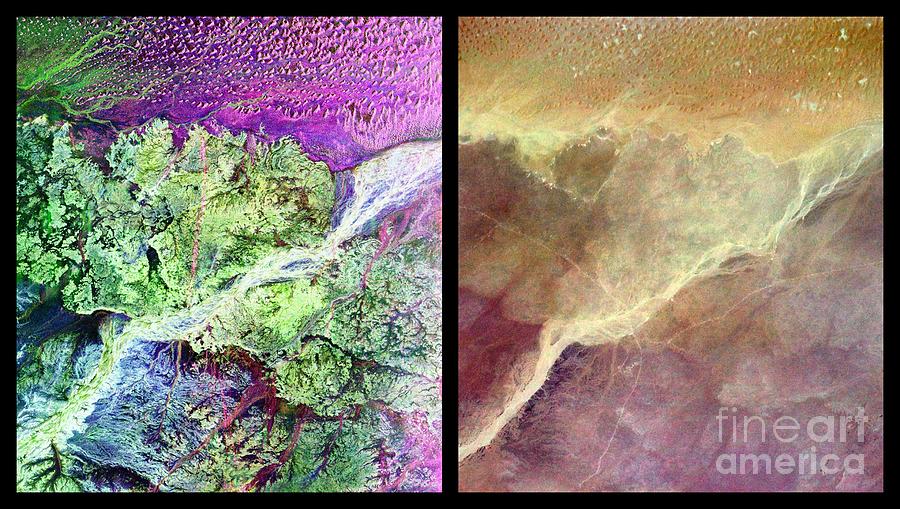

Ptolemy’s globe was a standard for geographers at that time. Saba Regio, the royal city of Sheba was at 73 X 16 degrees. Medina (known then as Yathrib) was at 71 x 23 degrees. In any case, Alexandria was the center of the world, and lines of latitude and longitude were constructed. It is unclear whether Ptolemy was the originator of this idea, or if he obtained his information from the Arab merchants that plied the world. (See ptolomaeus.html) Ptolemy knew the world was round, as did the educated world at the time, so Ptolemy constructed a globe of the world, with lines of latitude and longitude. Among them were several “Peripluses” or “round trips” recording coastlines, ports, and something on the lives of people at each stop. Claudius Ptolemy was born in Greece and lived in Egypt around 110-170 AD, and acted as the overseer of the Bibliotheca in Alexandria (Great Library, which had some 750,000 manuscripts). He notes on page 41 of his book that Ubar was located on Ptolemy ‘s Map of the World. But is the academic world convinced? To date, no one has published any proof that links the structure at Shisr with Ubar.Ĭlapp, the author of The Road to Ubar, Finding The Atlantis of the Sands, Houghton Miffin Company, New York, 1998 seems to indicate that he did most of the historical research. Suddenly the world was convinced that Shisr was Ubar. No one was sure what it was, until the article appeared the the New York times. When they started digging at Shisr, near the Arab fort, they began to uncover a large ancient structure. The LandSat photos were helpful, but the camel caravan routes through the desert had been noted many years before. The satellite imagery allowed us to eliminate sites so we could concentrate on the most probable areas.” Ranulph Fiennes later published his account “Atlantis of the Sands” Bloomsberry 1992 (right) as an effort to correct this misrepresentation. Zarins commented to him: “ The truth is, it was found by hard work, and excavation. (See a copy of an interview with him at: In his book, Atlantis of the Sands, Fiennes notes that Dr. The truth is, that the expedition was headed up by a group of people, one of them Nicolas Clapp, a world explorer known as Sir Ranulph Fiennes, and an archeologist Dr. It was assumed that these ruins were the remains of ancient Ubar. Blom had pointed out, they indeed discovered ruins in the deserts of Arabia. When the archeologists arrived at the spot that Dr. The scientists assumed that where many tracks merged, an ancient city must exist.

The ancient tracks acted like a road map. These tracks had persisted for a very long period, and after careful computer processing, the scientists were able to make them out on the Landsat pictures. However, because so little changes in the deserts of Oman and Yemen, he could see ancient paths and tracks in the desert. From the Landsat pictures, however, he discovered that there were no ruins of any ancient cities visible. He hoped that he could identify sites that archeologists could later investigate on the ground. Blom, compared maps made by Ptolemy, the Roman historian, with photographs from Landsat space satellites. The article claimed that a geologist and specialist in space remote-sensing technology from the Jet Propulsion Laboratory in Pasadena, California by the name of Dr. “Guided by ancient maps and sharp-eyed surveys from space” the article claimed “archaeologists and explorers have discovered a lost city deep in the sand of Arabia.” This article was then relayed all around the world and excitement grew. Then, in February 1992 an article by John Noble was splashed across the front page of the New York Times, declaring that the lost city of Ubar had been discovered. The king ignored him and a short while later the city disappeared from historical record and was buried under the sands of the Empty Quarter of Arabia.įor centuries, travelers in Arabia have looked for the lost city. This prophet foretold that the city and the entire civilization of Ubar would be destroyed by God, as punishment for their wicked living. One day, however, (as legend tells us) a prophet arrived on the scene and approached the last king of Ubar. According to legends and accounts by early historians, this city was fabulously wealthy as it was located on the overland incense trail. The legendary city of Ubar was once a center of trade and wealth.


 0 kommentar(er)
0 kommentar(er)
